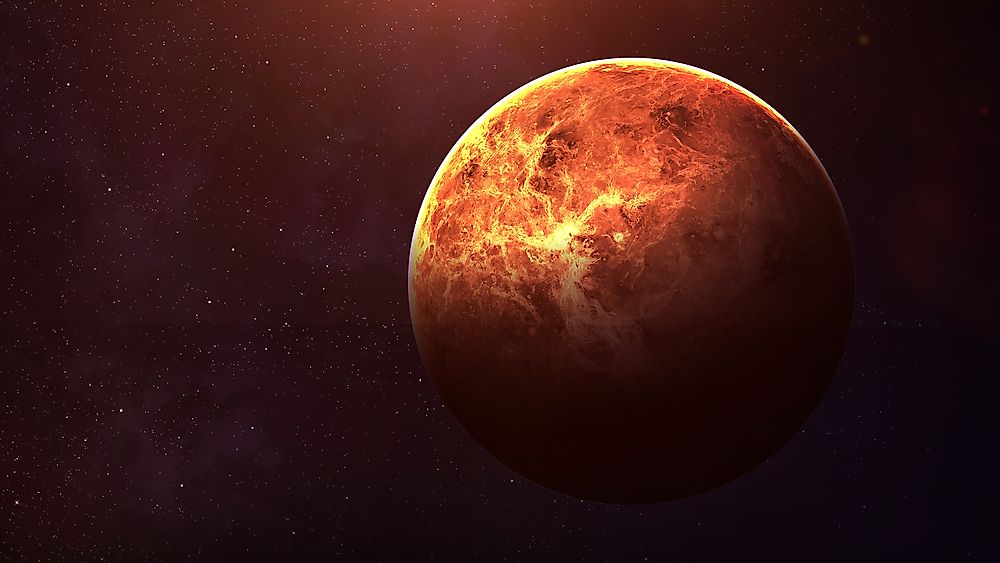10 Interesting Facts About Venus

Venus is the second planet from the Sun after Mercury, the third brightest object in the sky after the Sun and Moon, and the closest planet to Earth. Venus is commonly referred to as "Earth’s sister" since the two planets are similar in mass and size. The surface of Venus is hidden under a dense cloud of sulfuric gas that prevents probes from landing on its surface. Some interesting facts about Venus are described below.
Named After the Goddess of Love and Beauty
Venus is named after the Roman goddess of love and beauty because it is the brightest planet and was occasionally visible from Earth. Additionally, most features on the surface of Venus are named after female figures. Venus is visible in the morning and evening, and ancient skywatchers believed they were two separate bodies until Greek astronomers proved that they were indeed the same planet.
Venus Has No Rings or Moons
Venus and Mercury are the only planets in the Solar System without either a moon or ring. Researchers believe that the two planets had moons in their early stages of formation, but were later dislodged by the Sun’s gravity. Moons keep planets stable and protect them from rogue asteroids and comets.
Hottest Planet in the Solar System
Venus is significantly warmer than Mercury, even though the latter is much closer to the Sun. The average surface temperature on Venus is about 462 °C, while Mercury ranges from 420 °C on the brighter side to -176 °C on the dark side. The dense atmosphere, which is 96.5% carbon dioxide, traps heat, resulting in a greenhouse effect. The fast-moving winds distribute heat evenly throughout the surface of the planet.
Venus Has an Unusual Rotation
All planets spin in an anti-clockwise rotation and revolve around the Sun anti-clockwise, except Venus. The planet revolves anti-clockwise but rotates clockwise. This unusual movement puzzled astronomers until they realized that the planet was in an inverted position. It is believed that at some point in its early history, Venus collided with a massive celestial body that knocked it from the upright position.
A UFO in the Sky
Venus is so remarkably bright that some initially believed it was an unidentified flying object (UFO). The brightness of Venus is attributed to the dense cloud of sulfuric and carbon dioxide gas that reflects light from the Sun, making the planet visible from Earth. The phases of Venus are visible using amateur telescopes.
Active Volcanoes
Fresh lava flows through the surface of Venus, implying that volcanic eruptions are frequent, and have been ongoing for millions of years. There are fewer craters on the surface of the planet, unlike Mercury, since the lava flow covers most of the craters. The continuous existence of active volcanoes is attributed to the planet's extreme temperatures.
Spacecraft Grave
The atmosphere and surface of Venus are intolerable to both humans and machines. The immense pressure necessitates external shields for probes, while the carbon dioxide and sulphuric acid corrode metal quickly. For example, the 880 °F temperature melts sensitive parts, rendering aircraft unusable. Russia's Venera 1 space probe lost contact with Earth and is believed to have crashed before it began transmitting feedback, while NASA's Mariner 1 also failed to communicate. Mariner 2 was able to take measurements of Venus but could not penetrate the dense atmosphere. In 1966, the Russia's Venera 3 landed on the surface of Venus but could only last for 2 hours.
Longer Day than Year
Venus takes 225 Earth days to make a complete revolution around the Sun and 243 days to complete a rotation, meaning that a day is longer than a year. The planet rotates slowly due to the Sun’s gravity, which nearly locks it in an orbital tide.
Weak Magnetic Field
Venus has a fragile magnetic field, a feature that surprised scientists who expected it to be similar to that of Earth’s. A possible reason for this is that the entire core of Venus is molten and is not cooling as expected.
Earth’s Sister
Venus is commonly referred to as "Earth’s sister" because of the similarity in size and mass. Billions of years ago, the planet had a climate similar to Earth, and researchers believe that vast oceans existed on its surface. However, extreme temperatures resulting from the greenhouse effect evaporated the water, and the surface became too harsh to sustain life.











